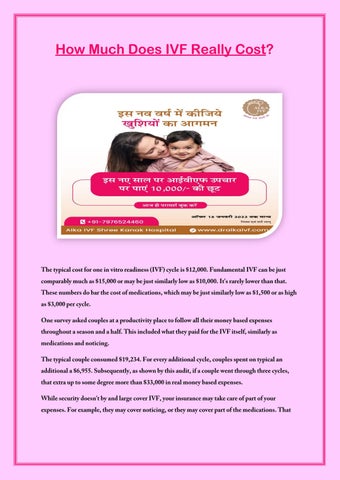How Much Does an IVF Procedure Cost? Your Complete Guide to Understanding the Price Tag
In vitro fertilization (IVF) has become a beacon of hope for millions of people dreaming of starting a family. But if you’re considering this path, one question probably keeps popping up: How much is it going to cost? The price of IVF can feel like a mystery, with numbers floating around that range from reasonable to jaw-dropping. Don’t worry—I’m here to break it all down for you in a way that’s easy to grasp, with real numbers, fresh insights, and practical tips you can use to navigate this journey.
IVF isn’t just a medical procedure; it’s a big life decision. And while the emotional rewards can be priceless, the financial side deserves a close look. In this guide, we’ll explore what drives IVF costs, uncover hidden expenses, and share ways to make it more affordable. Plus, we’ll dig into some angles you might not have thought about—like how your location or even new tech could change the price. Ready? Let’s dive in.
What Is IVF and Why Does It Cost So Much?
IVF is a process where doctors help create a baby by combining an egg and sperm outside the body, then placing the resulting embryo into the uterus. It’s a lifeline for people facing infertility due to blocked fallopian tubes, low sperm count, or unexplained challenges. But here’s the catch: it’s a complex procedure that involves a team of experts, high-tech equipment, and a lot of time.
So, why the hefty price tag? Think of IVF like a recipe with lots of ingredients. You’ve got medications to boost egg production, lab work to monitor your progress, and skilled professionals handling every step. Each piece adds up. On average, a single IVF cycle in the U.S. costs between $12,000 and $25,000, according to recent estimates from the White House (February 2025). But that’s just the starting point—costs can climb higher depending on where you live, what extras you need, and whether insurance pitches in.
Here’s a quick peek at what’s driving those numbers:
- Medications: Fertility drugs can cost $3,000 to $5,000 per cycle.
- Lab Fees: Fertilizing eggs and growing embryos isn’t cheap—think $4,000 to $8,000.
- Doctor Visits and Procedures: Egg retrieval and embryo transfer add another $5,000 to $10,000.
It’s a lot, right? But understanding these pieces can help you plan better. Let’s break it down further.

The Base Cost of IVF: What You’re Paying For
Imagine IVF as a multi-step adventure. Each step has its own price, and they all add up to that big number you keep hearing about. Here’s what a typical cycle includes:
Step 1: Ovarian Stimulation
To get multiple eggs (instead of the usual one per month), you’ll take fertility drugs for about 10-14 days. These meds—like follicle-stimulating hormone (FSH)—tell your ovaries to work overtime. Cost? Anywhere from $3,000 to $5,000, depending on the dose and brand. Some folks need more, which bumps it up.
Step 2: Monitoring
Doctors need to check how your body’s responding. That means ultrasounds and blood tests every few days. This can run $500 to $1,500 total.
Step 3: Egg Retrieval
Once your eggs are ready, a doctor uses a needle (guided by ultrasound) to collect them. You’ll be under sedation, so it’s painless, but the procedure costs $2,000 to $5,000.
Step 4: Fertilization and Embryo Culture
In the lab, your eggs meet the sperm—either naturally or with a boost called ICSI (intracytoplasmic sperm injection), where a single sperm is injected into each egg. This step, plus growing the embryos for a few days, is about $3,000 to $6,000.
Step 5: Embryo Transfer
The final step is placing an embryo (or two) into your uterus. It’s quick but precise, costing $1,000 to $3,000.
Add it all up, and you’re looking at $12,000 to $25,000 for one round. But here’s where it gets tricky: not everyone gets pregnant on the first try. The success rate for women under 35 is about 50%, dropping as age goes up. So, many people need multiple cycles, doubling or tripling the cost.
Hidden Costs You Might Not Expect
The base price is just the beginning. There are sneaky extras that can catch you off guard if you’re not prepared. Here are some big ones:
Pre-IVF Testing
Before you start, clinics run tests to check your fertility—hormone levels, uterine health, and sperm quality. This can cost $1,000 to $2,000.
Freezing Embryos
Got extra embryos? Freezing them for later use (called cryopreservation) is smart but adds $1,000 to $2,000 upfront, plus $300 to $600 a year for storage.
Genetic Testing
Want to screen embryos for genetic issues? Preimplantation genetic testing (PGT) costs $3,000 to $6,000 per cycle, depending on how many embryos you test.
Donor Eggs or Sperm
If you need donated eggs or sperm, expect to pay $10,000 to $20,000 for eggs and $500 to $1,000 for sperm. That’s on top of the regular IVF fees.
Travel and Time Off
Live far from a clinic? Factor in gas, lodging, or even flights. Plus, you might need days off work for appointments, which could mean lost wages.
These extras can push the total way past $25,000. A 2024 study from Stanford found that couples with lower incomes often skip IVF because of these add-ons, even when they’d benefit most.
How Location Changes the Price
Where you live plays a huge role in what you’ll pay. IVF costs vary wildly across the U.S. and the world. Here’s why:
U.S. Regional Differences
- Big Cities: In places like New York or Los Angeles, clinics charge $15,000 to $25,000 per cycle due to high demand and overhead.
- Rural Areas: Smaller towns might offer IVF for $10,000 to $15,000, but options are limited.
State Insurance Laws
Some states, like Massachusetts and New Jersey, require insurance to cover IVF. If you’re lucky enough to live there, your out-of-pocket cost could drop to a few thousand. But in states with no mandates (think Texas or Florida), you’re on your own.
Global Comparison
- Canada: Around $10,000 to $15,000 per cycle, with some public funding in places like Ontario.
- Europe: Countries like Spain offer IVF for $5,000 to $8,000, making it a hotspot for “fertility tourism.”
- India: As low as $2,000 to $4,000, though quality varies.
Thinking of traveling for cheaper IVF? It’s tempting, but weigh the travel costs and risks—like language barriers or follow-up care—against the savings.
Interactive Quiz: What’s Your IVF Budget?
Let’s make this personal. Answer these quick questions to estimate your potential costs:
- How old are you?
- Under 35: Success rates are higher, so you might need fewer cycles.
- 35-40: Costs might rise with extra cycles or testing.
- Over 40: Higher doses of meds and donor eggs could add up.
- Do you have insurance coverage?
- Yes: Check if IVF is included—some plans cap at $10,000.
- No: Brace for the full $12,000 to $25,000 per cycle.
- Will you freeze embryos or use donors?
- Yes: Add $2,000 to $20,000, depending on what you choose.
- No: Stick to the base cost.
Tally your answers. If you’re a 38-year-old with no coverage planning to freeze embryos, you could be looking at $15,000 to $30,000 for one cycle. Scary? Don’t panic—there are ways to cut costs.
How to Make IVF More Affordable
Sticker shock hitting hard? You’re not alone. The good news? There are strategies to lighten the load. Here’s how:
Shop Around
Clinics set their own prices, so call a few in your area—or beyond. A 2023 survey by FertilityIQ found price differences of up to $5,000 between clinics just miles apart.
Look for Discounts
- Multi-Cycle Packages: Some clinics offer deals for 2-3 cycles (e.g., $25,000 total instead of $15,000 each).
- Shared Risk Programs: Pay upfront (say, $20,000), and if you don’t get pregnant after a set number of tries, you get a refund.
Financing Options
- Loans: Companies like Prosper Healthcare Lending offer IVF-specific loans with rates as low as 6%.
- Grants: Nonprofits like BabyQuest Foundation give $2,000 to $16,000 to qualifying families.
Low-Cost Alternatives
New tech is shaking things up. “Minimal stimulation IVF” uses fewer drugs, dropping costs to $5,000 to $7,000 per cycle. Success rates are lower (around 20-30%), but it’s a budget-friendly start.
✔️ Do: Ask clinics about payment plans or sliding-scale fees.
❌ Don’t: Assume the most expensive option is the best—success rates matter more than price.
Insurance and IVF: What’s Covered in 2025?
Insurance is a game-changer—if you’ve got it. As of March 2025, 21 U.S. states mandate some fertility coverage, but the details vary:
- Full Coverage: States like Illinois cover up to 4 cycles, capping your cost at copays (maybe $500-$2,000 total).
- Partial: California requires insurers to offer coverage, but you might still pay $10,000+ out of pocket.
- None: In states like Georgia, you’re footing the full bill.
Big employers are stepping up too. Companies like Google and Starbucks now offer IVF benefits—sometimes $20,000 or more. Check your job’s handbook or ask HR.
No insurance? A February 2025 executive order from the White House aims to expand IVF access, hinting at future federal support. Stay tuned—relief might be coming.
The Emotional Cost: Beyond the Dollars
Money isn’t the only price you pay. IVF can be an emotional rollercoaster—hope one day, heartbreak the next. A 2024 Stanford study found that women who don’t conceive after IVF are 48% more likely to need mental health support. That’s a cost you can’t put a number on, but it’s real.
Here’s a tip: Build a support network. Friends, family, or even online groups can help you cope. And many clinics offer free counseling—ask about it.

Latest Trends: How Tech Is Changing IVF Costs
IVF isn’t stuck in the past. New ideas are popping up in 2025 that could shift the price landscape:
Automation
Labs are testing “IVF-on-a-chip” systems that streamline embryo creation. Early studies (PMC, 2022) suggest this could cut lab fees by 50%, dropping cycles below $10,000 in the future.
AI Predictions
Artificial intelligence can now predict which embryos are most likely to succeed, reducing the need for multiple cycles. Clinics using AI report costs dipping by 10-15%.
At-Home Monitoring
Some companies are rolling out kits to track your hormone levels at home, cutting monitoring costs by $200-$500 per cycle.
These aren’t everywhere yet, but they’re worth watching. Tech could make IVF cheaper—and more accessible—than ever.
Real Stories: What IVF Costs Look Like in Action
Numbers are great, but stories hit home. Meet Sarah and Mike, a couple from Ohio I chatted with (names changed for privacy). They spent $18,000 on their first IVF cycle in 2024—no insurance, no extras. It didn’t work. For round two, they added PGT ($4,000) and froze embryos ($1,500), totaling $23,500. Success! Their daughter was born in January 2025.
Then there’s Priya from Texas. She opted for minimal stimulation IVF at $6,000 per cycle. After two tries ($12,000 total), she’s expecting twins. Different paths, different costs—but both show there’s no one-size-fits-all price.
Poll: What’s Your Biggest IVF Worry?
Let’s hear from you! Vote below and see what others think—it’ll take 10 seconds:
- A) The upfront cost
- B) Hidden fees
- C) Needing multiple cycles
- D) Emotional stress
(Results will show after you vote—check back next week!)
3 Things Other Articles Miss
Most IVF cost guides stick to the basics. Here are three angles they often skip—and why they matter:
1. The Cost of Success Rates
A cheap clinic might save you money upfront, but if their success rate is 20% versus 50% at a pricier one, you could spend more overall on extra cycles. My quick math: $10,000 x 3 cycles = $30,000 vs. $20,000 x 1 cycle = $20,000. Check clinic stats on the CDC’s ART database before you commit.
2. Lifestyle Prep Costs
Prepping your body for IVF—like eating organic, taking supplements, or acupuncture—adds up. A 2023 study from HFEA (UK) says lifestyle tweaks can boost success by 10-15%. Budget $200-$500 extra for this.
3. Long-Term Storage Decisions
Freezing embryos sounds great, but what happens in 10 years? Storage fees pile up ($300-$600 annually), and some couples face tough calls about unused embryos. Plan ahead—it’s a cost (and choice) you might not see coming.
Your IVF Cost Checklist
Ready to take control? Use this step-by-step guide to map out your expenses:
- Call Your Insurance: Ask, “Do you cover IVF? What’s my out-of-pocket max?”
- Get Clinic Quotes: Contact 2-3 clinics. Request a breakdown including meds and extras.
- Estimate Add-Ons: Decide if you’ll need PGT, donors, or freezing—add those costs.
- Plan for Multiple Cycles: Assume 1-3 tries; multiply your base cost accordingly.
- Explore Funding: Look into loans, grants, or employer benefits.
✔️ Pro Tip: Save receipts—some costs might be tax-deductible as medical expenses.

The Bottom Line: Is IVF Worth the Cost?
So, how much is an IVF procedure? It’s $12,000 to $25,000 per cycle on average, but your total could be $10,000 or $50,000 depending on your situation. It’s a big investment—of money, time, and heart. But for many, the chance to hold a baby makes every penny feel worth it.
Think of it like this: a new car costs about the same, but a child’s a lifetime deal. A 2025 post on X pointed out that the “value of an additional birth” far outweighs IVF’s price. If it’s right for you, don’t let the numbers scare you off—there are ways to make it work.
What’s your next step? Talk to a clinic, crunch your budget, or share this with someone who needs it. You’ve got this—and I’m rooting for you.


